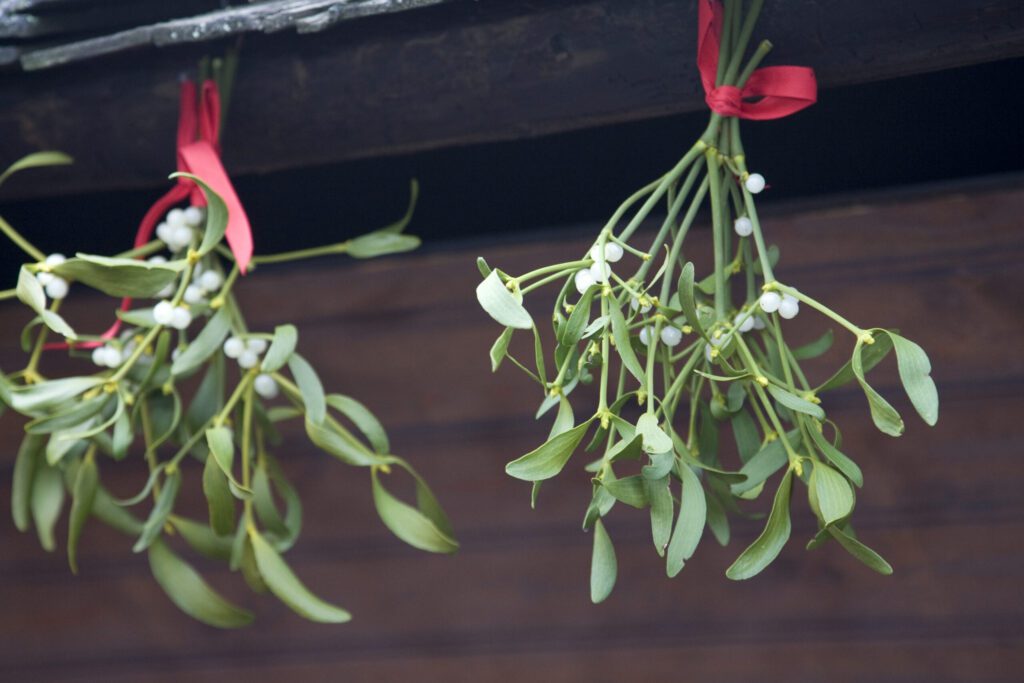There’s More to This Plant Than Movies Will Tell You
by TIM CRAIG
Every December there are certain things you can count on: holiday music in every store, extra cookies and snacks appearing out of nowhere, and nonstop Hallmark movies like “The Mistletoe Promise,” where people find romance in unlikely places and unbelievable ways.
But the story on mistletoe is a little more complicated. Is it a hanging parasite with the green leaves and the white berries? Is this parasite a symbol for romance? Is there anything good that can come of it? The answer to all three questions, of course, is “yes.”
Mistletoe the Parasite
Technically, mistletoes — there are more than 1,000 species found throughout the world to which botanists ascribe the name — are hemi-parasites, which means they obtain a portion of their energy through photosynthesis, and the rest is extracted from other plants. As a small seedling, it roots into the bark and wood of a tree and makes a connection with the growing ring of the host. Although mistletoe makes its own food, it steals water and nutrients from its host tree.
Because of its parasitic nature, mistletoe can weaken or destroy the trees it infests, especially if the tree has been compromised by pests, storms, or old age. Removing mistletoe may help revive the tree, according to UF/IFAS.
Mistletoe’s distinctive green leaves, stems, and white berries — each with a sticky seed inside — are easily recognizable. The species has evolved to plant themselves on hosts ranging from pine trees to cacti. The American or oak mistletoe only grows in deciduous trees, which shed their leaves annually.
In Florida, mistletoe is most commonly found in laurel oaks. Other known hosts include elms, hackberries, sycamores, and wild cherry trees.
It is this deciduous-based species that is commonly associated with European-based mistletoe mythologies, like kissing beneath it on Christmas.
Mistletoe the Lover
Mistletoe’s mystic properties are most associated with the Celtic Druids in the First Century A.D., who noticed that the plant stayed green and healthy even when the tree it was on was bare. Its evergreen leaves symbolized the promise of spring’s return. In Scandinavian mythology, mistletoe was a symbol of peace. The English and French adapted these beliefs, though it’s not clear why people began kissing under mistletoe. Origin stories include that people saw it as a sign of fertility
Hanging mistletoe is a Christmas tradition in the U.S., while in Europe, it is more commonly associated with New Year’s Eve. In the U.S., kissing under the mistletoe used to be a lot more complicated. Men commonly gave women as many kisses as there were berries on the mistletoe hanging above them, plucking off one per kiss.
In literature, some scholars say that mistletoe is the “golden bough” mentioned in Virgil’s Aeneid, written between 29 and 19 B.C.. Charles Dickens wrote of mistletoe traditions in The Pickwick Papers in 1837. American author Washington Irving, in 1820, wrote that mistletoe “with its white berries, hung up, to the imminent peril of all pretty housemaids.”
Mistletoe the Healer?
Peril? During the holidays it can be a peril, according to the U.S. Poison Control Center. Most cases of mistletoe ingestion are during Christmas. Children account for 92 percent of the cases and 96 percent of the cases are by swallowing. However, despite its reputation as dangerous, the Poison Control Center reports a majority of the patients felt no symptoms and there were no fatalities — including for the 72 people who swallowed mistletoe on purpose.
There is also evidence to suggest that some species of mistletoe can be used in treating cancer — something that people have actually used it for since the 1920s. Doctors today can prescribe mistletoe in Europe.
At Johns Hopkins’ School of Medicine, doctors are studying mistletoe’s effects on cancer patients in the U.S. According to oncologist Channing Judith Paller, previous research suggests that the parasite could at minimum help “ameliorate side effects of traditional therapy,” such as the nausea, vomiting, and loss of appetite that often accompanies chemotherapy.
“There have been trials that looked at mistletoe as an anti-cancer treatment, and there have been trials that looked at improving quality of life. Many trials show benefit in both survival and quality of life, but those trials were not at the FDA gold standard with placebo controls,” Paller says in 2019.
Mistletoe’s low-risk, high-reward reputation piqued her interest. Because patients reported tumor shrinkage, higher energy levels, and significantly reduced pain, Paller began her study.
Paller’s study continues today. As does the tradition of kissing under the mistletoe. And it only survives as a parasite to trees.
So this holiday season as you look at that ball of green leaves and white berries hanging in a doorway, consider the conundrum it represents: parasite, lover, and healer.

